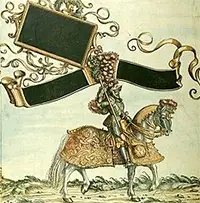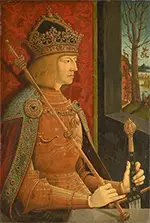Maximilian I: Holy Roman Emperor and Habsburg Superstar
Part 2: European Center Stage In 1496 and 1497, Maximilian arranged the marriage of both of his children to children of Spain's King Ferdinand II and Queen Isabella I. In 1496, Philip married Joanna of Castile; the following year, Margaret married John, Prince of Asturias. Within a decade, Philip was King of Castile, the first Habsburg monarch of Spain, and Margaret was Governor of the Habsburg Netherlands. As the 16th Century began, the French king Louis XII was pressing his case in northern Italy, making claims for the Duchy of Milan. The Duke of Milan was Galeazzo Maria Sforza, father of Maximilian's third wife. Thus, Maximilian and France again came into conflict. The Italian Wars, as historians generally refer to them, ensued, and Maximilian later joined the Holy League in an effort to combat French influence on the Italian peninsula. At the same time, Maximilian's forces were doing battle with the Swiss, who prevailed in the 1499 Battle of Dornach, achieving independence for the Swiss Confederacy. Maximilian spearheaded a number of imperial reforms, in governance and in law. Resulting were a centralized chancery and treasury. The Diet of Worms in 1495 introduced Roman Law throughout the Holy Roman Empire, extending it to German courts and displacing German law. At the same time, he introduced a penal code that regulated punishments, including making it more difficult for torture to be used. In the same vein, Maximilian expanded on the regulations that his father had introduced in terms of military discipline and created a military code, among the provisions of which was the prohibition of violence against civilians. No stranger to being on a horse, Maximilian nonetheless had a hard fall, in 1501, and suffered a severe leg injury. He suffered pain from this injury from then onward. 
One of the titles that Maximilian didn't inherit from his father right away was that of Holy Roman Emperor. That throne had often remained vacant for a time. Also, the tradition had been that the pope crowned the new emperor. However, the Italian Wars prevented Maximilian from traveling to Rome to accept the crown and so in 1508, Pope Julius II agreed to recognize Maximilian as Elected Roman Emperor. Thus, his reign as emperor began on Feb. 4, 1508. In that same year, Maximilian joined the pope, France, and Spain in the League of Cambrai, in opposition to the Republic of Venice, which was throwing its weight around. His son Philip had died two years earlier but had been the father to six children: Eleanor, Charles, Isabella, Ferdinand, Mary, and Catherine. Seeking more consolidation, Maximilian arranged a meeting with the kings of Poland and of Hungary & Bohemia. At the First Congress of Vienna, in 1515, the monarchs agreed that Louis, son of King Ladislau II of Hungary & Bohemia, would marry Maximilian's granddaughter Mary and that the emperor's grandson Ferdinand would marry Anne, Louis's sister. A weary Maximilian had a stroke in 1518, after having a premonition that his death was imminent. He was bedridden and not rise again, dying on Jan. 12, 1519, at Wels, in Upper Austria. His only son, Philip, had died in 1506. Maximilian had arranged for Philip's oldest son, Charles, to be the next Holy Roman Emperor. And so it was, when Spain's Charles I became Emperor Charles V, as well as King of Germany. 
The legacy of Maximilian I is a complex one. He did much to centralize authority in the Holy Roman Empire, and he made alliances that bolstered the Habsburg claim to supremacy in Europe. He took a special interest in weaponry and fighting, particularly hunting and jousting, but his successes on the battlefield were few and far between. He was quite the patron of the arts, encouraging playwrights and musicians to ply their craft within his realm. Vienna became a prime location for musicians to compose and perform. He was an avid collector of the written word, building on the 110-book collection begun his father and the large number of manuscripts he inherited from his father-in-law and expanding the imperial library to be one of the largest of its time. He encouraged the production of maps and scientific treatises and encyclopedias. One of his prize possessions was a map showing all of the roads built by the Roman Empire. More mundanely, he championed the pavings of alleys and streets with cobblestones and required waste to be disposed of out of sight. He also had developed the first modern postal service ever. First page > Growing into the Role > Page 1, 2 |
|
Social Studies for Kids
copyright 2002–2024
David White




